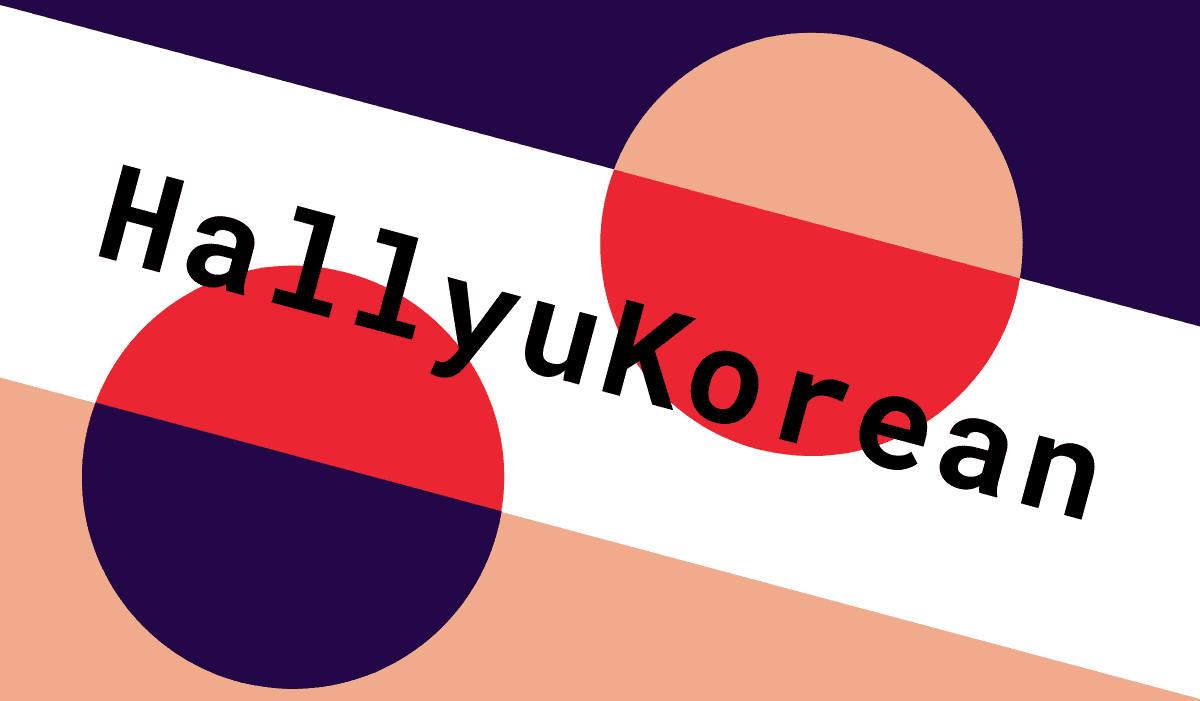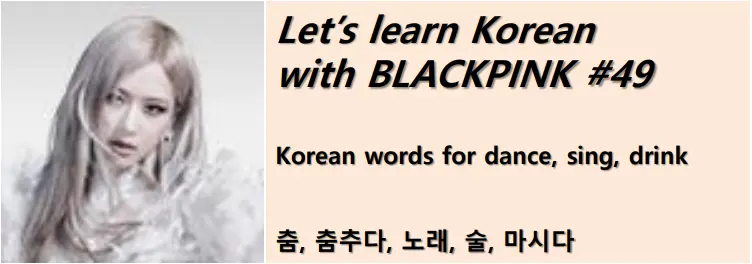Korean words for dance, sing, drink : 춤, 춤추다, 노래, 술, 마시다
Let’s learn Korean words for dance, sing, drink with BLACKPINK lyrics.
Click the play button below to listen to all the BLACKPINK lyrics used in this post.
춤 [chum] dance
이제서야 나를 위해서 춤을 출 수 있어
i-je-seo-ya na-reul wi-hae-seo chu-meul chul su i-sseo
Now I can dance for myself
*이제서야(now) +
나(I) + 를(object particle) +
위해서(위하다(care for) + ~해서(in order to)) +
춤(dance) + 을(object particle) +
출 수(추다(dance) + ~ㄹ 수(dependent noun)) +
있어(be)
(*Verb stem + ~아서/어서/해서 indicates the relationship in time between 2 closely related events or the causes of subsequent events.
Also, it’s used to indicate the reason for the succeeding event.
Verb stem + ~ㄹ 수 있다 means ‘can’ and Verb stem + ~ㄹ 수 없다 means ‘can’t’.)
춤추다 [chum-chu-da] to dance
너와 춤추고 싶어
neo-wa chum-chu-go si-peo
I want to dance with you
*너(you) + 와(with)
춤추고 싶어(춤추다(dance) + ~고 싶다(want to))
(*~고 싶다 is used to express the speaker’s wishes.)
노래 [no-rae] song
매일매일 밤 밤 이 노래를 불러 불러
mae-il-mae-il bam bam i no-rae-reul bul-leo bul-leo
Every, every night, night I sing, sing this song
*매일(every day) + 매일(every day) +
밤(night) + 밤(night) +
이(this) +
노래(song) + 를(object particle) +
불러(sing) + 불러(sing)
(*Some words are repeated in this sentence because it is a song lyric.
It is more natural to say “매일 밤 이 노래를 불러” in everyday conversation.)
술 [sul] alcohol, liquor
마시다 [ma-si-da] to drink
술은 마셔도 연락은 씹지마 yeah
su-reun ma-syeo-do yeon-ra-geun ssip-ji-ma yeah
Even if you drink, don’t ignore my calls, yeah
*술(liquor) + 은(topic particle) +
마셔도(마시다(drink) + 아/어도(even if)) +
연락(contact) + 은(topic particle) +
씹지마(씹다(chew) + ~지마(don’t))
(*연락을 씹다 means ignoring a call, message, e-mail, etc.)
Grammar Reference
The most common Korean particles are listed below.
Subject particle: 이 / 가
Topic particle: 은 / 는
Object particle: 을 / 를
이, 은, 을 for nouns ending with a consonant, 가, 는, 를 for nouns ending with a vowel.
| 이/가 | 은/는 | 을/를 | |
| 춤 | 춤이 | 춤은 | 춤을 |
| 노래 | 노래가 | 노래는 | 노래를 |
| 술 | 술이 | 술은 | 술을 |
*Tense
*Present tense : Adjective/verb stem + ~아/어/해요
*Past tense : Adjective/verb stem + ~았/었/했어요
*Future tense : Adjective/verb stem + ~(으)ㄹ 거예요 / ~ㄹ 게요/ ~겠어요
The basic way to get the verb/adjective stem is to remove 다 from the verb/adjective.
If there is a vowel ㅏ or ㅗ on the final syllable of the adjective/verb stem, 아요(present tense), 았어요(past tense), 을 거예요(future tense) is used.
If there is a vowel other than ㅏ or ㅗ on the final syllable of the adjective/verb, 어요(present tense), 었어요(past tense), ㄹ 거예요(future tense) is used.
Also, if there is 하다 in the adjective/verb, 하다 changes to 해요(present tense), 했어요(past tense), 할 거예요(future tense).
Below you can see the conjugation of 잘하다, 잘못하다 by tenses.
| Present tense | Past tense | Future tense | |
| 춤추다 | 춤춰요 | 춤췄어요 | 춤출 거예요 |
| 마시다 | 마셔요 | 마셨어요 | 마실 거예요 |
*Speech levels
The three most commonly used Korean speech levels are 합쇼체 (formal polite), 해요체 (informal polite) and 해체 (informal plain).
*The formal polite style : Adjective/verb stem + ~(스)ㅂ니다
~(스)ㅂ니다 is used more in formal or public situations including the military, news, reporting presentations, meetings and lectures. It’s mainly used to address large gatherings or people you don’t know personally.
*The informal polite style : Adjective/verb stem + ~아/어/해요
~아/어/해요 is most commonly used in everyday life. Compared to the formal polite style, the informal polite style is softer and less formal, so it is mainly used among family members, friends, shopkeepers and other close acquaintances.
*The informal plain style : Adjective/verb stem + ~아/어/해
As for the informal plain style ~아/어/해, it is mainly used among friends from superiors to people of lower rank and among family members.
Below you can see the conjugation of 잘하다, 잘못하다 by speech levels.
| Formal polite | Informal polite | Informal plain | |
| 춤추다 | 춤춥니다 | 춤춰요 | 춤춰 |
| 마시다 | 마십니다 | 마셔요 | 마셔 |

